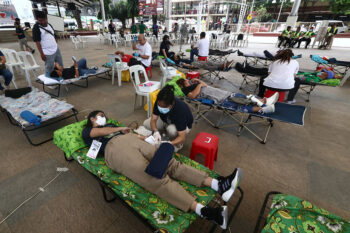GENERAL SANTOS CITY (MindaNews/26 October)—Members of the T’boli tribe in Kiamba, Sarangani are expecting to earn more from producing abaca (Textilis musa) now that they have received assistance from a World Bank-funded project implemented by the Department of Agriculture.
The Lumads (indigenous peoples) who belong to the Kapate Abaca Farmers Association got the assistance under the Adaptable Program Loan Phase 2 of the Mindanao Rural Development Program (MRDP2).
Lealyn A. Ramos, program director of MRDP said that together with the local government unit they have provided 2,750 tissue-cultured abaca suckers for tinagak production.
Tinagak is a local term for a continuous thread of fine quality, similar-sized fiber formed into small bales that weigh a kilo each. One bale of tinagak weighing a kilo takes at least four days to finish.
MRDP also extended P250,000 to the lumad group for the purchase of a brand new mechanical stripper, Ramos said in a statement.
The anti-poverty program is being implemented in Mindanao’s 26 provinces and 225 municipalities. It is a $135.12-million project with $90 million obtained as a loan from the WB.
According to the Fiber Industry Development Authority (FIDA), the national production of abaca fiber went up by 4.6% to 236,501 bales of 125 kilograms or 29,562.6 metric tons (MT) in January to July this year, with exports of the fiber to major markets like United Kingdom and Japan going up by 200%.
“We have been planting abaca since our forefathers but it’s only this time that we are earning higher income,” said 35-year old Erdelina Ababol, an association member.
“With the help of Department of Agriculture and FIDA, we are now making tinagak which sells for P250.00 per kilo,” she added, noting the big difference from their previous income.
Previously, the association sells abaca fibers, produced by manual stripping, cheaply at P35 to P40 per kilo because of the low quality, Abalol said.
“Using also the old manual stripper is time-consuming, very laborious and costly since half of the total sale of abaca is paid to the stripper,” she added.
Data from the Agriculture Department showed that almost 90% of the world’s abaca export is produced in the Philippines and Ecuador accounts for the rest.
Mindanao remains a top producer of abaca fiber with the Davao Region, Caraga region, and the Autonomous Region in Muslim Mindanao (ARMM) as among the bulk producers next to the Bicol and Eastern Visayan Regions.
Bicol delivered 10,139.13 MT produced from 81,113.1 bales of 125 kilos. The Bicol region accounted for 34.4% of total production for January to July.
With production of 62,590.7 bales of 125 kilos or 7,823.8 MT, Eastern Visayas is the country’s second top producer of abaca fiber.
The Davao region contributed 29,864 bales of 125 kilos or 3,733 MT; Caraga region 19,634 bales of 125 kilos or 2,454.25 MT; and the ARMM 14,232 bales of 125 kilos or 1,770 MT. (MindaNews)







